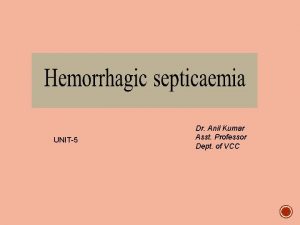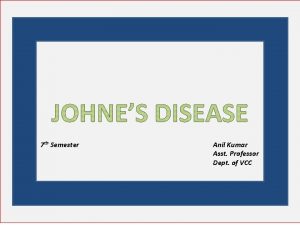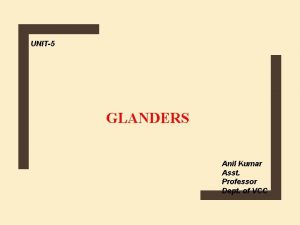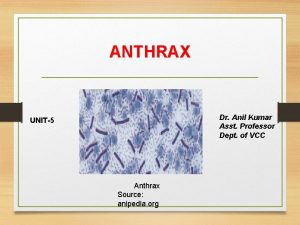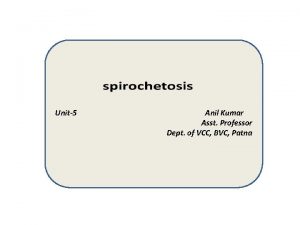VMD412 Dr Anil Kumar Asst Professor Dept of






- Slides: 6

VMD-412 Dr. Anil Kumar Asst. Professor Dept. of VCC

HS (Shipping/transport fever, stockyard’s disease, Barbone disease, Galaghotu in Hindi. ) Definition Etiology Host Range Precipitating factors An acute highly fatal disease characterized by acute septicaemia, high fever, swelling at the ventral aspect of throat , neck and brisket causing dyspnoea • Pasteurella maltocida type 1 or B, G –ve, Known as Bipolar organism • Buffalo>Cattle>Pig>Horse>Sheep & Goat • Affect any age and group • Maximum occurrence- During Monsoon • Stress (Transportation, Heavy worm, Starvation and Viral infections like IBR, Parainflenza-3)

Transmission • Ingestion or inhalation • The initial site of proliferation thought to be the tonsillar region. • The source of infective bacteria is thought to be the nasopharynx of bovine carriers. Organism→ from environment → enters into terminal bronchioles and alveoli→ causes changes in lungs in presence of predisposing factors→ destroying the leucocytes and macrophages→ and then release of histamines and PGF 2 alpha and sometimes fibroblastic elements→ leading to septicemic changes in body and inflammatory changes in lung parenchyma--→ and produce pneumonia with the help of secondary invaders (Parainfluenza-II, Bovine herpes virus and other bacteria) → Death due to asphyxia

Clinical findings Diagnosis HS in buffalo - Vet Extension • High Fever (106 -107º F), Profuse salivation, Petechiae om mucous. • Edematous swelling (Under throat, neck and brisket region) • Swellings are hot and painful • Increased respiration, Grunting sounds followed by dyspnoea • Death • Clinical findings • Seasonal occurrence make tentative diagnosis • Animal inoculation • Serologiacl (HAT, HIT, CFT etc. )

Treatment Prevention and control • Various sulfonamides (130 -150 mg/Kg, IV for 3 -5 days), tetracyclines, penicillin and chloramphenicol are effective if administered early. • Anti-inflammatory • Antihistamins • Supportive therapy • Prevention is by vaccination. • Three kinds of vaccine are widely used: plain vaccine (HS broth vaccine), alumtype precipitated vaccine, and oil-adjuvant vaccine. • The most effective bacterin is the oiladjuvant-one dose provides protection for 9 -12 month; it should be administered annually. • The alum-precipitated-type bacterin is given at 6 months intervals. • Age of vaccination: Above 5 -6 months of age

THANKS







